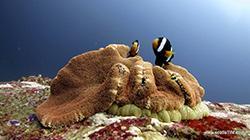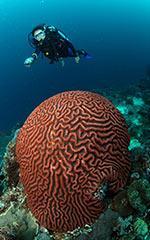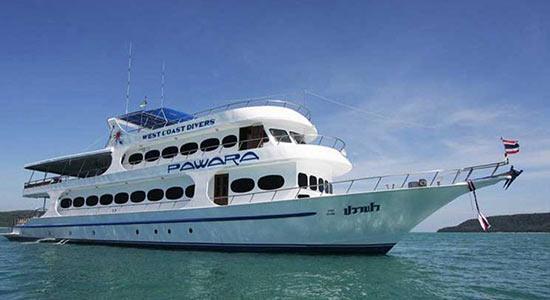 Scuba diving in Thailand is an extremely popular sport and growing every year. It is good fun, and educational for new divers to learn about marine conservation as well as that sharks and other sea creatures should be treated with respect, rather than fear. It is good for the country's economy as it enables local and international businesses to prosper, including attracting local tourists and those from abroad. Thailand has many beautiful islands, beaches and diving spots on both its coasts. From a diving visitor's point of view, there are a few aspects to consider when choosing the best places in Thailand to go scuba diving. The two coasts, Gulf in the east and Andaman Sea to the west, have several different areas for scuba diving, some of which are better for accommodation, non-diving activities, and of course different kinds and levels of diving conditions and marine life.
Scuba diving in Thailand is an extremely popular sport and growing every year. It is good fun, and educational for new divers to learn about marine conservation as well as that sharks and other sea creatures should be treated with respect, rather than fear. It is good for the country's economy as it enables local and international businesses to prosper, including attracting local tourists and those from abroad. Thailand has many beautiful islands, beaches and diving spots on both its coasts. From a diving visitor's point of view, there are a few aspects to consider when choosing the best places in Thailand to go scuba diving. The two coasts, Gulf in the east and Andaman Sea to the west, have several different areas for scuba diving, some of which are better for accommodation, non-diving activities, and of course different kinds and levels of diving conditions and marine life.
 Starting with the eastern side of Thailand's coasts, there is the famous Koh Tao Island. This is probably the most visited place for scuba diving in Thailand, with more than two dozen diving schools and centres and many budget travellers taking part in PADI courses and fun diving. Although neighbouring Koh Samui and Koh Pha Ngan also have diving centres, most of the best diving sites in The Gulf of Thailand are to be found around Koh Tao. Further north, between Bangkok and Cambodia, there are three more areas for scuba diving in Thailand. Pattaya is a beach resort near the capital with lots to do for families and nightlife partygoers but the diving there is nothing special due to shallow waters which offer very little marine life and poor visibility. Koh Chang and Koh Kood are further southeast from Pattaya and are near the Cambodian border. Here there is a good selection of dive sites dotted around the two islands. Koh Kood is the nearest island to Cambodia and in Thailand's easternmost waters. In both Koh Chang and Koh Kood there is excellent diving to be had in extremely clear and medium-depth water. In the deep south of Thailand's east coast in The Gulf of Thailand there is almost nothing in the way of diving centres or dive sites worth visiting.
Starting with the eastern side of Thailand's coasts, there is the famous Koh Tao Island. This is probably the most visited place for scuba diving in Thailand, with more than two dozen diving schools and centres and many budget travellers taking part in PADI courses and fun diving. Although neighbouring Koh Samui and Koh Pha Ngan also have diving centres, most of the best diving sites in The Gulf of Thailand are to be found around Koh Tao. Further north, between Bangkok and Cambodia, there are three more areas for scuba diving in Thailand. Pattaya is a beach resort near the capital with lots to do for families and nightlife partygoers but the diving there is nothing special due to shallow waters which offer very little marine life and poor visibility. Koh Chang and Koh Kood are further southeast from Pattaya and are near the Cambodian border. Here there is a good selection of dive sites dotted around the two islands. Koh Kood is the nearest island to Cambodia and in Thailand's easternmost waters. In both Koh Chang and Koh Kood there is excellent diving to be had in extremely clear and medium-depth water. In the deep south of Thailand's east coast in The Gulf of Thailand there is almost nothing in the way of diving centres or dive sites worth visiting.
 On Thailand's west coast, which becomes The Andaman Sea and then The Indian Ocean, the diving is far superior in most cases. The seas are deeper and clearer due to the undersea topography and ocean currents. There's also more marine life, fed by the nutrient-rich water. Starting in the northernmost seas on Thailand's western side, the Surin Islands are home to the best diving site in all of Thailand, and among most experts' 'world top tens.' Richelieu Rock is a submerged pinnacle in the shape of a horseshoe that sits on a sandy seabed 50 metres below the waves. It almost reaches the surface, giving divers something to look at throughout the dive, but it is too deep and remote for snorkelling. A little further south from The Surin Islands is the popular archipelago known as The Similan Islands. Here is an oasis of islets 60km. from the mainland surrounded by more than twenty fantastic dive sites. Although none are as good as Richelieu Rock at its best, the quantity and variety of fish, corals and topography makes it the best place in Thailand for diving. Like the Surin Islands, most diving visitors choose between a day trip on a speedboat or catamaran and spending two nights to a whole week aboard a liveaboard diving boat. Similan liveaboards are available for all-inclusive prices as low as $300US with equipment rental, food & drinks, and national park fees in the price. There are also luxury cruisers which offer passengers five-star service throughout the trip. There's something to fit everyone's schedule, budget and requirements, even those who travel with children and non-diving passengers. Although The Surin Islands and Similan Islands have the best diving in Thailand, it is worth noting that the area is closed to the public during the rainy season (May-Oct.) due to rough sea conditions. Diving there is better suited to experienced scuba divers, but inexperienced divers and those who have never dived or snorkelled before can learn to do so at The Similan Islands.
On Thailand's west coast, which becomes The Andaman Sea and then The Indian Ocean, the diving is far superior in most cases. The seas are deeper and clearer due to the undersea topography and ocean currents. There's also more marine life, fed by the nutrient-rich water. Starting in the northernmost seas on Thailand's western side, the Surin Islands are home to the best diving site in all of Thailand, and among most experts' 'world top tens.' Richelieu Rock is a submerged pinnacle in the shape of a horseshoe that sits on a sandy seabed 50 metres below the waves. It almost reaches the surface, giving divers something to look at throughout the dive, but it is too deep and remote for snorkelling. A little further south from The Surin Islands is the popular archipelago known as The Similan Islands. Here is an oasis of islets 60km. from the mainland surrounded by more than twenty fantastic dive sites. Although none are as good as Richelieu Rock at its best, the quantity and variety of fish, corals and topography makes it the best place in Thailand for diving. Like the Surin Islands, most diving visitors choose between a day trip on a speedboat or catamaran and spending two nights to a whole week aboard a liveaboard diving boat. Similan liveaboards are available for all-inclusive prices as low as $300US with equipment rental, food & drinks, and national park fees in the price. There are also luxury cruisers which offer passengers five-star service throughout the trip. There's something to fit everyone's schedule, budget and requirements, even those who travel with children and non-diving passengers. Although The Surin Islands and Similan Islands have the best diving in Thailand, it is worth noting that the area is closed to the public during the rainy season (May-Oct.) due to rough sea conditions. Diving there is better suited to experienced scuba divers, but inexperienced divers and those who have never dived or snorkelled before can learn to do so at The Similan Islands.
Nearer to Thailand's most popular international tourist location and largest island (Phuket) there are scores of diving centres offering day trips to local dive sites. Most of the diving from Phuket takes place at The Racha (Raya) Islands to its south and on the way to, or at, Koh Phi Phi to its east. Although Phuket's west coast faces the beautiful Andaman Sea, there are not many good diving spots to be found within daytrip distance of the island. Phuket has a little bit of everything for everyone with regards to activities and nightlife. It's a little too hectic and expensive for some tastes but the island is large enough to rent a car or motorcycle and get away from it all. The Racha Islands are very quiet and should really receive many more tourists than they do. There are a dozen or so great dive sites dotted around the Racha Islands, and divers visit them from Phuket or dive centres on the islands themselves. Koh Phi Phi is now world famous for its pristine beaches, lack of motor transport, crystal clear waters and party atmosphere. Some feel that it has become overdeveloped and exploited, having a negative effect on its beauty while prices keep increasing for everything. 44km. further southeast from Phi Phi, towards the mainland, Koh Lanta is becoming extremely popular. It is quite different from Phi Phi in as much as it is larger and has a perimeter road with resorts doted around. The waters are clean and clear but some beaches are not as easy to walk up and down stopping at restaurants or shops. Diving from Koh Lanta usually takes place at a few local dive sites as well as Koh Phi Phi's. Koh Haa (Five Islands) is a group of granite and limestone islets with ten or more fantastic dive sites. Koh Haa is visited by Koh Lanta and the smaller Koh Mook (Muk) diving centres and, like the Similan and Surin National Marine Parks, is closed to the public during the rainy season. The final diving area near to Phuket is Hin Daeng and Hin Muang. These are two pinnacles which just about break the water's surface during low tides. Being situated far from everything else, they attract lots of healthy marine life, including regular visits from large pelagic species such as Manta Rays and Whale Sharks. While it's possible to dive up to 70 metres below the surface at Hin Daeng and Hin Muang, there is far more light, colour, and time underwater for those who stay at more sensible depths.
In Thailand's deep south on the west side there is a growing industry for tourism, including scuba diving. The infrastructure is still a little underdeveloped and the diving sites have not been fully explored and mapped, but reports suggest that there is a good future for the area. It is important for the locals and authorities to keep the right balance between overdevelopment and convenient facilities. While they may be trying to learn from past mistakes on other islands, it is important to understand that most tourists don't want to travel across the world and only have the option of high standards at high prices. There are still many people who want to live in a bamboo hut on the beach for a few Dollars.
 In summary, the cheapest good diving near Bangkok is to be found in and around Koh Tao. While the groups of divers to each instructor or PADI Divemaster may be larger than on the west coast, the whole set up works incredibly well and it's a very sociable experience. Diving there is more for young travellers on a budget who want the choice of different diving opportunities and the chance of seeing a Whale Shark. Koh Phi Phi probably has the best daytrip diving sites in Thailand, which is proven by dive boats from Phuket, Koh Lanta and The Racha Islands visiting every day. Here everything, including the diving, is more expensive than Koh Tao, but the experience is better too. This mainly refers to water clarity and the diversity of marine life. However, without a doubt, the best diving sites in Thailand are found far out to sea from the west coast. Richelieu Rock is the best single dive site, but the best place to go scuba diving in Thailand has to be The Similan Islands. Day trips are popular, with journeys of two hours each way sandwiching two daytime dives. However, staying on Similan Liveaboards allows passengers to dive four times per day – at dawn, mid morning, mid afternoon and at night. Trip prices may look high, but when considering that accommodation, food and drinks are included it all of a sudden becomes a bargain. The $-per-dive ratio makes the best diving in Thailand also the best value diving in Thailand.
In summary, the cheapest good diving near Bangkok is to be found in and around Koh Tao. While the groups of divers to each instructor or PADI Divemaster may be larger than on the west coast, the whole set up works incredibly well and it's a very sociable experience. Diving there is more for young travellers on a budget who want the choice of different diving opportunities and the chance of seeing a Whale Shark. Koh Phi Phi probably has the best daytrip diving sites in Thailand, which is proven by dive boats from Phuket, Koh Lanta and The Racha Islands visiting every day. Here everything, including the diving, is more expensive than Koh Tao, but the experience is better too. This mainly refers to water clarity and the diversity of marine life. However, without a doubt, the best diving sites in Thailand are found far out to sea from the west coast. Richelieu Rock is the best single dive site, but the best place to go scuba diving in Thailand has to be The Similan Islands. Day trips are popular, with journeys of two hours each way sandwiching two daytime dives. However, staying on Similan Liveaboards allows passengers to dive four times per day – at dawn, mid morning, mid afternoon and at night. Trip prices may look high, but when considering that accommodation, food and drinks are included it all of a sudden becomes a bargain. The $-per-dive ratio makes the best diving in Thailand also the best value diving in Thailand.


